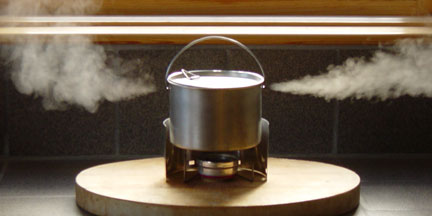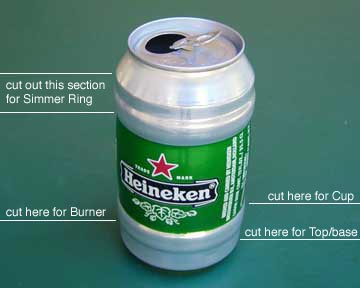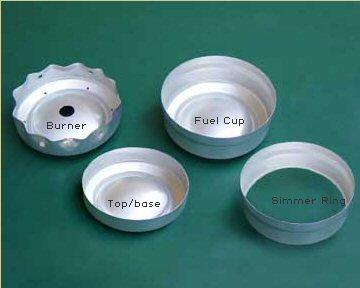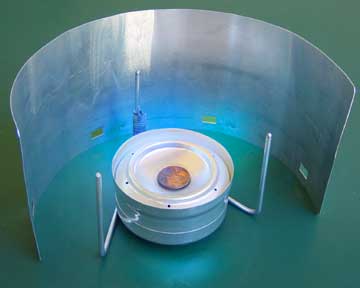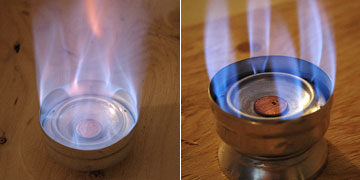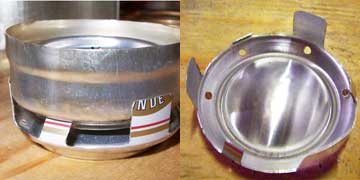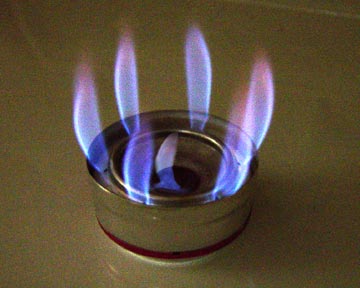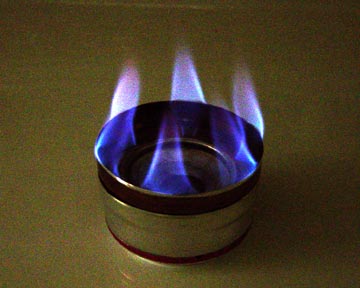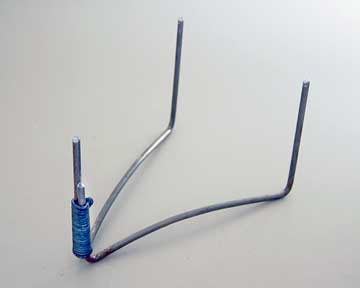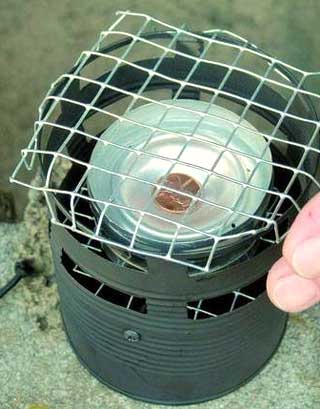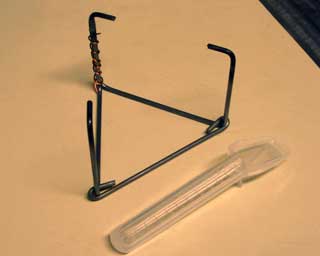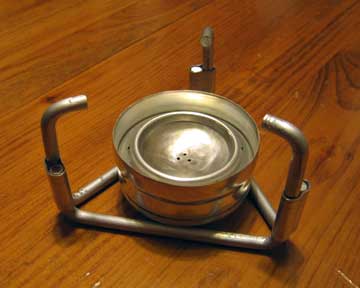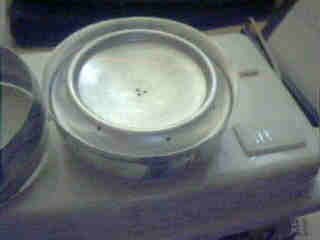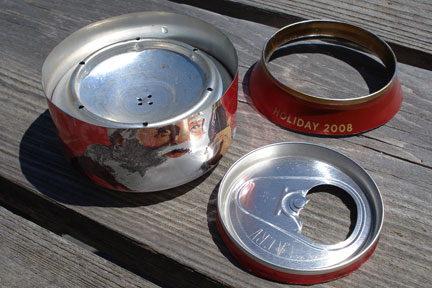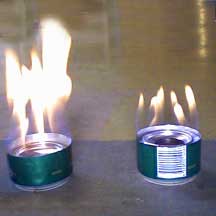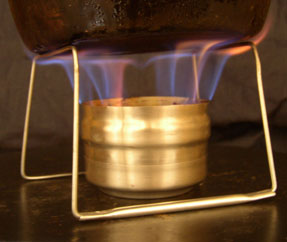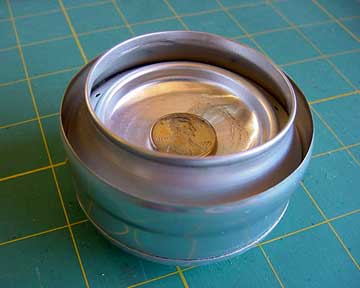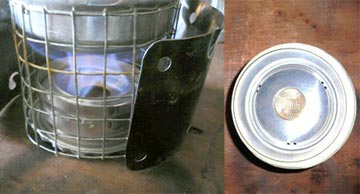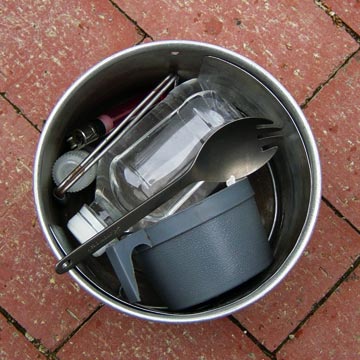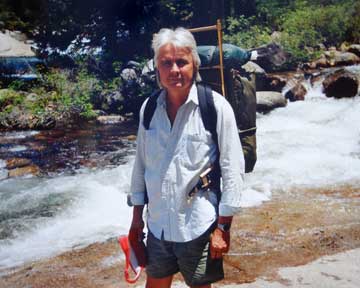Penny Stove Home | Instructions & FAQs | Alcohol Stove Myths | Penny Wood Stove | Favorite Recipes | 1/2 Penny Instructions | Links
I share this stove to help help keep canisters out of landfills.
If you want to thank me, please send a check to your local
wilderness preservation fund.
| Penny Stove HTML Instructions |
|
| The building instructions below are brief - designed for those that have previously built 'can' stoves. You should also check the Frequently Asked Questions shown below. Or, pint the PDFf Instructions and PDF FAQ's section shown on this page.
The Heineken can has raised bands that provide perfect diameter and spacing for all of the parts. Three cans are needed to make the stove. Another kind of pop or beer can actually works better for for the top/base. Cut with a knife and finish with large scissors.
Top/base should be shorter than shown (about 1/2" tall). The Burner (3/4" tall) is cut off just below the first band. The Fuel Cup is cut off at the top of the band (making it about 1 1/4" tall). The Simmer ring uses the top band and complete top flat section (about 7/8 " tall).
The burner has a 1/4" hole as show, or three 1/16" holes, drilled in the center and six 1/16" holes spaced outside the ring drilled vertically from outside the can (see lines). Needle nose pliers were used to make 12 dimples or folds. These must end 1/4" short of the top edge. Then, a small hole punch was used to make holes in the folds to release hot gases to the inside of burner. 12 are shown, but 6 (every other fold) tested just as good. If you don't have a punch, just drill 12 - 1/16" holes instead... it will work fine. * WARNING The solution is to sand the Burner cup to remove the number bumps - 320 sand paper works fine. You can also use a socket and hammer to tap the penny into the Burner center to help it seal the opening - it should hold the fuel in the top cup indefinitely. Another solution is to use a regular pop (sprite) or beer (Guinness) can for the burner - (see Can I use a pop can burner without crimps? below). In addition, a good safety solution is to drill 3 or 4 - 1/16" holes in the burner center instead of the single 1/4" hole. These must fit under the penny. This may keep flames out of the burner even if the penny is removed Mike Martin recommended this change.
The burner is carefully tapped into the fuel cup until it hits bottom and provides a tight seal. A clean press fit between the burner and the cup is important because it keeps primer fuel from draining and heated gasses from leaking while burning.
The top/base is used as an insulated support for the fuel cup. This helps keep a stable temperature in the stove and provides protection under the stove. I now use a soda can for the top/base and cut it down until the stove sits firmly without tipping. As Rob Lineberger suggests, you can may also want to polish the bottom to make a fire starting reflector as described at Wildwood Survival.
Two "U" shaped wires wrapped together with thin wire form the pot pupport. Drip irrigation stakes work best. Three legs make a stable base- supporting the pot at least 1" above the burner. My windscreen is a section of aluminum Dryer vent. Tests show that screen is not necessary in good weather and only increases one quart boil times by 30 seconds.
Modefied 2 quart Open Country pot (6oz.) is large enough to melt snow, sterilize water, wash clothes, or shampoo hair. The stove, support, and screen fit inside the pot (total 8.3oz). An 8oz. bottle of alcohol (about 12 fully cooked meals) fits inside along with a spork, cup, scrub pad, soap, matches, lighter, salt, pepper, coffee, tea, and towel. Total cook kit is less than 20oz.
The top/base can be used as a cover for storage or to seal the stove and save fuel between meals. I now use the bottom of a pop can with one 1/16" hole in the bottom- it's lighter and fits tight without getting stuck - no need for the handle. Simmer ring slips over the bottom of the stove (not shown in this photo). The package is small enough to store inside of a plastic camp cup. |
|
|
Frequently Asked Questions |
|
| What if the flame is too big? |
There is really only one thing that can go wrong with the construction of this stove - a leak between the cup and the burner. You can check by filling it in the dark - covering the penny to the top of the cup. Light and watch the edges and see if the fuel leaves the outer ring quickly - this would indicate a leak. Once primed, check and see if there is any flame around the edge of the cup - again indicating a leak.
The left picture shows the results of a leak between cup and burner. As flame burns in the gap, it can expand the cup and make the gap larger resulting in a flame thrower. To fix this you can fill the gap with JB Weld as outlined in the FAQ's section below. |
What if the fuel runs under the Penny too soon? |
Apparently some of the new cans have numbers molded on the bottom. These bumps may keep the penny from sealing the burner opening allowing fuel to run under the penny before the stove gets hot. If this happens it sometimes lets flame enter the opening causing a disconcerting POP as fumes inside the Cup blow off the penny - this is not good. Also, sometimes the stove jets will not light because fuel has run into the cup before it is heated. |
What if I don't drink? |
You can make the stove with only one Heineken can and use soda or beer cans for the burner and base (see Bill Waite Penny Stove System ). |
|
How does it work? |
Burning fuel in the center and outer ring of the burner heats the Cup and fuel. The heat causes fuel in the the center to run under the penny into the Cup and start to boil. Fuel in the outer ring lights the six Jets as gasses are released from boiling fuel in the Cup. The pot and wind screen reflect the heat and accelerate the heating process. The Base insulates the hot Cup to maintain a stable boil. |
|
What kind of alcohol should I use? |
I use Denatured alcohol for tests but use Evearclear ethanol alcohol on the trail because I can drink it, use it to sterilize cuts, or to disinfect my hands and water containers - one bottle does it all!. DO NOT USE Rubbing Alcohol, it burns dirty and contains water that could cause a steam bubble and blow the penny off of the stove. Below are notes on extensive stove burn tests by Mike Martin: |
What is the best way to light the stove? |
To boil 2 cups: |
How can I light the stove when it's really cold? |
Sometimes, if it's really cold, the primer fuel in the outer ring burns out before the fuel boils and jets light. When this happens, I put my hand over the burner to make sure it is out. Then, add a few drops of fuel in the outer jets ring and light the stove again.
Jared "...modified the base to act as a primer. It only takes about 5-6 drops of fuel and gets the stove primed & roaring very quickly... " |
| How can I boil in less time? | The fast boil times are the result of the stoves efficiency - speed was not an original design goal. But, if you want to race your friends, or need that morning coffee a few seconds faster - like in 3+ min. - there are two things you can do: make it prime faster and/or make it burn hotter. Each will make the process a little less convenient and efficient however. |
Why are there so few jets and why are they so big? |
Several years ago, when I designed the stove, most high performance stoves had 24 tiny jets. Now many are down to just eight. I can only assume that this is based on testing as was my choice of six + the center burner used under full burn. David Lubertozzi use a #60 bit to make a Penny with twelve -0.040" burner holes to equal the same area as the original and found that it "didn't perform any better than six at 1/16", in fact a bit worse." Many have tried using multiple tiny holes with the same result. Whatever jet configuration you use, the size and number should be balanced to produce enough pressure to cause a center flame when the stove is fully heated, but no flame at the beginning and end of a burn. This helps to maintain a consistant flame contact with the pot.
A gas stovetop burner has an open center to allow all jets 360° access to fresh oxygen. Alcohol stoves cannot have a central air supply. The Penny, unlike other pressure stoves, has spaced jets to allow oxygen to flow 360° around the flames and also to feed the central flame (just starting in this photo). Because the full pot bottom is heated by fully mixed fuel it heats faster and burns more efficiently. |
How does the Simmer Ring work? |
Do NOT extinguish the stove, just drop it on (small end down) whenever you want to slow the burn.* It shields the edge of the Cup from the flame, cools the Cup, and slows the alcohol boil. It also reduces the air supply and raises the smaller flame much closer to the pot for maximum efficiency. For maximum simmer time, you can start the stove with the ring in place.
Tests show that 1-1/3 oz. (40ml) will burn for about 40 - 50 min. 2/3 oz. (20ml) will burn for 18 - 20 min. 1/3 oz. (10ml) will burn for about 10 min. - heat 2 cups of water for perfect tea - no boil however. |
How can I drop the simmer ring on without burning Myself? |
Have your friend do it... |
| What is the best way to cut the cans? | I spin the can and hold a Sharpie pen to mark the cut. You can use a book and set the pen on a page the holds it at the appropriate height. |
| What is the best way to insert the Burner? | I have always just tapped the burner into the Cup. I set a small measuring cup on top and tap with a wooden spoon. Recently, Mark Warren proposed this brilliant idea: |
How can I evenly space the six jet holes? |
You could make a pattern but this is not necessary. If they look evenly spaced, they are way good enough. |
How can I make perfect Burner crimps? |
This is what I do: |
Can I use a soda can burner without crimps? |
Yes, it will work almost as well. Most soda cans are a little smaller in diameter. Phil Perkins "found that by using an 8 oz. Pepsi can as the burner you don't need to crimp it. It slides right in." The burner side wall should be shorter - between 3/8" and 1/2". A non-crimped Burner will not heat quite as fast and buckle if tapped to hard into the Cup, and any bends could cause a leak, so go easy. I still recommend a soda can burner WITH crimps because it gives you essentially a double wall stove. |
Can I use a burner without punched holes? |
The holes in the burner crimps let hot gasses access to the inside of the burner where the jets are. In some rare situations, like a really high fill, this releases the pressure and keeps the burner cup gap from leaking. You can build it without those holes however and it works fine almost all of the time. If you don't have a small punch, I suggest that you just use the same 1/16" burner drill bit to drill these in each crimp near the top. It will work just as well. |
| How do you make the pot support? | I used drip tubing stakes - about 6" long U shaped wires used to tie down drip irrigation lines.
|
|
Can I use other pot supports? |
You can use any of the great pot support ideas found on the Web but it must let in lots of air and not reflect heat back to the stove. Also, make sure that the pot is at least 1" from the top of the cup rim. A little more distance will heat faster, simmer shorter and be more susceptible to the wind. Less distance will heat much slower and use much more fuel.
Duane Rapp says "I got a length of 1/8" steel welding rod and made the bends like Bill Waite instructed. Instead of aluminum tubing, I just wound some 18-22 gage (cant remember what it is) solid strand copper wire (insulation removed) around the two supports. I used a 6" length of the steel rod, and made a 4" long straight section, with loops around on both ends. I slip the loops over both ends of the pot stand and it makes a much more stable stand...
Milton Barker "used wire cutters to cut a section of light gauge “hog” wire in sufficient length to form a circular pot support... and you don’t have the concern of stab wounds. It is best to pack this base in a pot or it will be flattened even though it can be reshaped."
|
Can I use the BIG 24 oz. cans? |
Yes, it makes a great base camp, boat, camper, or winter stove. Jesse Stovall followed the instructions but used big cans and says:
|
Can I use soda cans instead? |
Yes. This regular pop/beer can stove can be built with only two standard cans. The Burner is cut 3/4", crimped slightly around the bottom edge then carefully pressed into the cup. The cup is 1 1/4" tall and the pot should be set 7/8" to 1" above the top edge. This stove is best lit by filling the stove completely (2 oz.) to cover the penny. Or by using a base that helps heat the stove. Once lit, performance is similar to the original Penny - burn times with a full load of fuel is over 30 min. It will boil one quart of 60° water in about 11 minutes. If you normally boil only 2 cups, I suggest you check out the 1/2 Penny link at the top of the page. Don't forget to add the penny!
Tony Ciavarella built the stoves above to the recommended specs using Aussie beer cans. He found the flame "quiet aggressive, with flame height 2-3 inches....approx 40.5ml of...methanol...burned for 15 minutes...14 fluid oz to a rolling boil in 5min30sec, compared to 7min00sec for a Trangia... He increased the cup height and "made three burners cut at 19mm, 22mm and 30mm up from can base...with different burn rates, some better for simmering, some better for a quick boil."
|
| Can I use those strange British cans | David Elder from the UK worked out the problems with making the stove using those UK Heineken cans with different proportions and a raised label area. He has just loaded his suggestions on a blog. He made a simmer ring and everything - see image below. I suggest that you visit David at:
|
How can I make a small pot stove? |
First, turn the pot support upside down. Then, light the stove with the Simmer Ring on. This will slow the burn but also focus the flame on the center of the pot. If you find the burn too slow, cut about 1/8" off of the top of the Ring to let in more air.
Or try the optional "Bill Waite Simmer Ring" shown above to focus more flame into the center. Bill "...used a can opener to remove the inside end (the top) of a Heineken can (leaving the rim) and it works super...The finished diameter of the ring end of the can... would work well for smaller pans. Some can openers work better than others. This is the model that I've used for cutting the ends out of hundreds of cans. http://www.seniorshops.com/goodgripcano.html "
Greg Vaillancourt was inspired by the Minibulldesign Nion2 that has jets positioned in pairs (right next to each other). Greg says that his tri-pared configuration shown above "really works well. The flames are focused and burn with a nice clean blue flame. A 1/16th" bit was used to drill the jets."
Jared built Greg's tri-paired stove and "...modified the base to act as a primer. It only takes about 5-6 drops of fuel and gets the stove primed & roaring very quickly... using 1 1/4oz of Methanol and 2 cups of 70-degree-F water in the Heineken pot. It boiled in 5:30 from the time the pot went on the burner and kept boiling for another 5 minutes!" |
How can I fix a leak between the Cup and Burner? |
This is a very low pressure stove so a perfect seal is not necessary. However, a small leak can sometimes let priming fuel in the outer ring run down into the cup before the jets are lit... this IS a problem. Usually the leak is caused by a small crease in the Cup produced by a Burner crimp. A leak can sometimes overheat and expand the Cup and make the fuel burn too fast. This can also keep the simmer ring from working. |
Can I use other wind screens? |
Yes, tests show that a taller wind screen (or heat reflector) will sometimes improve efficiency and boiling times, but not as much as on other stoves. It is also much less affected by moving air. Also, this stove burns very hot and needs lots of air so make sure that intake holes and exhaust space around the pot are generous. |
How do you pack this thing? |
Modified Open Country pot, stove in cup, 8 oz. fuel, windscreen, pot support, lighter, matches, salt/pepper, pot bail, spork, pot scrubber (bottom). Coffee, tea, coco, and a few snacks sit on top and the lid holds everything together.
Ultralight and ultracheep version using a $6 K-Mart Grease Pot - with lid, stove, support & windscreen = 5.5 oz.. Set up for a long trip with 8 oz. of fuel, spoon, salt, lighter, matches & tea = 15 oz. total. I replaced the pot lid knob w/ cord for easy packing and added a bale wire from a paint can. Stove is wrapped in paper towel.
Small Pringlses Can idea for storing the stove outside the pot and/or for storing multiple stoves. Duane Rapp found that "There is enough room to pack one stove with cap/base, a standard and Bill Waite simmer ring. Use the paper towel to stop rattling. Alternatively, you can pack two stoves (second one minus cap/base) a standard simmer ring, and a Bill Waite simmer ring. |
| My wife is concerned about my sanity - what do I do? | This is a common problem when one spends hours messing with old beer cans - or full ones for that matter. Playing with stoves can be addictive and I suggest that you think about some tips that I use with my addictions. |
| Where did the penny idea come from? | I just wanted an efficient stove that I could make on the trail. And, having used an Optimus 8R pressurized gas stove for years, I knew that sealed self-pressurizing stoves often overheat and/or burn slow at the end when heat is needed most - they can also be very dangerous. After messing around with jet and center hole sizes, making low and no pressure stoves (similar to the newer Vargo), using the bottom of two cans (like Photon Stove), using a crimped burner as a double wall (like Pepsi Stove), and spaced jets to simulate an air jacket (like Cat Stove ), I realized that a center hole of any size would alter jet height during the burn. One day, looking for a low-tech way to regulate pressure, I dropped on a penny and that was it - the perfect solution. The six 1/16" jets that I was using turned out to provide the perfect pressure combination for optimum jet height and simmer. Later, when I first saw the shape of the Heineken can, I knew it would could provide the lid, base, proper jet spacing, priming fuel area, and insulating simmer ring. I was a little surprised that the self-filling, self- measuring, and self-priming features actually worked however. So, I guess it came to me like most good ideas do, some combination of experience, persistence, and luck - mixed with necessity and laziness. As my friend Bill Jones once said - "If I had all the right stuff, I'd never be able to design anything"... |
| So...How DOES the fuel get under the penny? | It's all very technical and complex. My guess is that the surface tension drops as the alcohol gets hot and the copper and aluminum heat at different rates causing a shift. At that point, divine intervention takes over as your mate comes in to ask if you plan to burn the house down......
|
| Who is Mark Jurey? | I'm an industrial designer and have been lightweight backpacking since before ripstop nylon - note recent pic of my 40 year old Stephenson tent and pack (2.5 lb. each). Over the years I survived heat, altitude, wind, rain, and an August blizzard that killed three heavily prepared packers. I learned valuable lessons about life and nature, including; If it can break, it probably will; The ultimate hi-tech solution is often the most basic; and, simple multi-use tools are the key to a happy and healthy adventure. Mark Jurey My Backward Garden www.jureystudio.com |
Disclaimer & Warning |
|
|
Information on this site is provided for educational purposes only. Neither the webmaster nor anyone else whose information may be included on, or linked to, this web site can attest to or endorse the safety of using any techniques, equipment, supplies or services evaluated or referred to therein. Any endorsement or recommendation is limited solely to the evaluator's opinion about their effectiveness when used for their intended purpose in accordance with safe operating procedures, and if available, in accordance with any instructions provided by the inventor or manufacturer. Some survival and outdoors equipment and supplies are inherently unsafe and can injure, maim or kill even when used appropriately. |
|
Back to Top
©2004,5,6 mark jurey
